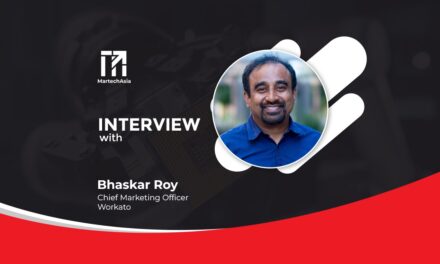In this exclusive interview, Matt Preschern, Chief Marketing and Demand Generation Officer at NTT Ltd., talks about the evolving role of the CMO and how the pandemic has changed the marketing ecosystem in Asia.
The interactions between solution providers and their clients as well as prospects have changed irrevocably at a fundamental level with the onset of the pandemic. Today’s B2B customers are digitally empowered and better informed than ever before – prospects and customers are now interacting with enterprises on their own terms whenever they choose to. As a result, the key challenge in the buyer journey isn’t one of sales but of information.
It is therefore imperative that CMOs and their teams vigilantly interpret buyers’ needs and transform them into a cohesive experience across all brand touchpoints and enterprise departments. This also means that the importance of omnichannel marketing capabilities has exploded considerably – in fact, the new bar for omnichannel excellence is now ten or more channels over three engagement modes (in-person, remote, and self-service), delivered 24/7.
In this exclusive interview, Matt Preschern, Chief Marketing and Demand Generation Officer at NTT Ltd., touches on the above points and more. NTT Ltd. is a leading IT infrastructure and services company and as a part of the global NTT Corporation, the company serves 65% of the Fortune Global 500 and 80% of the Fortune Global 100. Matt is an award-winning marketer, having been named among the top 20 most influential CMOs by Forbes and recognized for his success in driving marketing innovation by the CMO Club.
Tell us about yourself. What is your current role and what is a typical day like for you?
I’m the Chief Marketing and Demand Generation Officer at NTT Ltd. I joined NTT a year and a half ago to drive innovation in Marketing and create a world-class Marketing and Communications Function.
What’s great is that there isn’t a “typical” day, especially when you work for a leading global technology company. What’s exciting about being NTT Ltd.’s global CMO is the diversity of the work and the team. We truly have a global team – team members across Europe, Asia, the Americas, and South Africa. While I’m based in the United States, I travel extensively to be with the team, our London headquarters, of course, but also across the globe to see and work with the team first-hand. And the work ranges from building our brand to our web presence – creating a new website – to pipeline, demand generation to Social, Media and Analysts Relations to Sports Sponsorships and much more. All our work is focused on driving business results. Marketing needs to be a strategic element for the company and one that drives tangible results. With all that – I can honestly say, no one day is the same!
How has the Pandemic changed the ecosystem of marketing in Asia? Or are things coming back to normalcy?
Marketing is a core function of modern business and plays a significant role in driving profitable growth for the company. This has become magnified in the post-pandemic environment.
It is widely accepted that the pandemic has accelerated organizations’ transition to the digital space, and in the context of the customer journey, the way those prospects interact with your company has become completely different.
Changes to the buyer’s journey
Research has revealed that potential buyers interact with brands between 15 to 20 times before the first actual interaction with the company. As a result, these digitally empowered buyers are better informed than ever before and will even know about your company, services, or solutions even before you start conversing with them – like in traditional sales – which also means that today’s buyer journey isn’t about sales, but of information which essentially disintermediated the front end of the historical sales process
One of the key takeaways over the past two years is that it is entirely possible to conduct business without face-to-face interactions – studies have shown that remote sales reps can reach four times as many accounts in the same amount of time and generate up to 50 percent more revenue.
Looking ahead
However, in-person meetings are also unlikely to go away as buyers and sellers will continue to seek opportunities to have personal interactions above and beyond sales and marketing.
Instead, the future of buyer journeys lies with hybrid interactions. Hybrid marketing offers the brand the flexibility to engage with the customer across multiple digital touchpoints without missing out on the opportunities to build personal relationships through in-person interactions.
Companies that will come out on top from this trend are those with marketers that found the right balance between digital and physical interactions.
What is the importance of omnichannel marketing in today’s digital environment?
In recent reports, 77% of APAC businesses have experienced a surge in new customers through digital channels over the past 18 months. Against this backdrop, close to half of businesses in the APAC region are looking to prioritize an omnichannel approach to better tackle and anticipate industry challenges for the next 3 – 5 years.
B2B buyers have become comfortable turning to digital and online channels to meet their purchasing needs. In fact, B2B buyers use up to and sometimes more than ten digital channels as part of any given purchase – which is double the number of channels five years ago.
With so many different platforms in this digital world, marketers need to adapt and improve the buyers’ experience across all the different touchpoints and enterprise departments to reach them effectively.
Can you advise some best practices towards incorporating a holistic hybrid approach for the marketing function?
The state of B2B marketing has evolved dramatically in recent years. Technological advancements along with changing industry preferences and behaviours have led businesses to rethink their marketing strategies many times over especially on the back of the pandemic.
Amongst the wide array of strategies that are currently being employed by marketers, here are some key trends and tactics that marketers can take note of and leverage:
- the use of the latest emerging technology such as AI and chatbots, as well as staying up to date with existing software available in the market including Eloqua, Marketo, and Terminus.
- adoption of integrated platforms to capture and convert leads (automation and effective communication to track and manage sales data)
- focus on personalization – B2B buyers in Asia have expressed a greater need for personalization as compared to B2C buyers. In fact, 65% of B2B buyers might switch brands if they do not receive personalized communications from their vendors.
- leveraging video content and influencer marketing on business platforms such as LinkedIn – 65% of B2B buyers rely on review sites and peer recommendations while 54% take to social media to research solutions and vendors.
How do you see the role of the CMOs in a customer-centric market and the need for stronger cross-collaboration between functions?
The role of the chief marketing officer is changing, as it is heavily attached to customer demands – from being expected to lead enterprise transformation around customer experience to becoming savvier about the business and utilization of data.
In a recent survey, the key priorities by CMOs in the region were identified as: increasing market share (66%), improving marketing processes, particularly measuring effectiveness (60%), and increasing customer satisfaction ratings (55%).
With that, the CMO role has evolved to an extent where they are now responsible for customer experience as well as financial and strategic tasks; alongside the traditional duties that come with building a successful brand. The CMO of today must be able to engage both the right and left sides of the brain, developing a successful marketing strategy whilst thinking analytically about revenue and business growth.
It is no longer a siloed role but requires them to work across functions, including CIOs and CTOs, to better tap on things such as disruptive technologies – aimed at addressing the digital demands of customers and partners for a multi-channel approach.



















